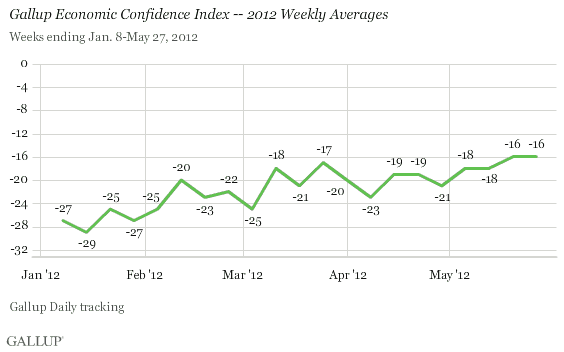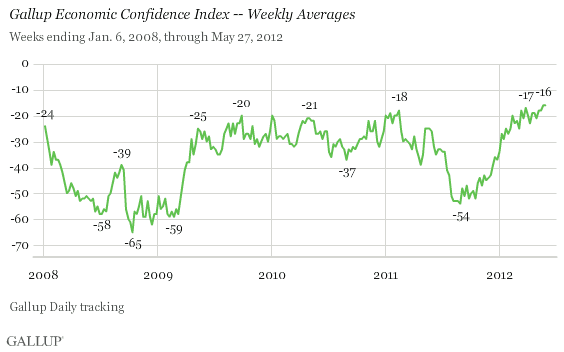PRINCETON, NJ -- The Gallup Economic Confidence Index held at -16 last week, the highest the index has reached in the four-plus years of Gallup Daily tracking in the United States. This is slightly improved over the -18 readings in the first half of May, and up significantly from -27 at the start of the year.

Longer term, the index has fully recovered from the near-record-low -54 it fell to last summer as a political battle raged in the U.S. over raising the debt ceiling. The index is now marginally higher than its level at the start of 2011, which in turn was slightly improved over the high points reached in 2009 and 2010, and slightly better than where it stood at the beginning of January 2008.

The Gallup Economic Confidence Index is an average of two components of consumers' psychology: Americans' ratings of current economic conditions and their perceptions of whether the economy is getting better or getting worse. The index has a theoretical maximum of +100, obtained if all Americans say the economy is excellent or good and improving. The index could go as low as -100 if all Americans perceive the economy as poor and getting worse.
Americans' perceptions of current economic conditions were up slightly last week, with 17% describing conditions as "excellent" or "good" and 37% as "poor," for a net economic conditions rating of -20, the best since September 2008. At the same time, the -12 economic outlook score (reflecting 42% of Americans saying the economy is improving and 54% saying it is worsening) was down slightly, resulting in stability in the overall Economic Confidence Index for the week.

Bottom Line
Americans' economic confidence has been improving by baby steps for much of 2012 after a more rapid rise out of near-economic despair last summer, and that is continuing in May. At -16 for the week ending May 27, the index once again came in higher than the -20 average for all of April, indicating overall confidence will be up slightly this month. To be sure, Gallup Daily tracking reveals that the rise in confidence has been fairly bumpy on a weekly basis, but the overall trend is positive and -- assuming the government's upcoming unemployment report for May is consistent with the slight decline in unemployment Gallup found in mid-May -- it seems likely to continue on this track for at least another month.
Gallup.com reports results from these indexes in daily, weekly, and monthly averages and in Gallup.com stories. Complete trend data are always available to view and export in the following charts:
Daily: Employment, Economic Confidence, Job Creation, Consumer Spending
Weekly: Employment, Economic Confidence, Job Creation, Consumer Spending
Read more about Gallup's economic measures.
View our economic release schedule.
Survey Methods
Results are based on telephone interviews conducted as part of Gallup Daily tracking May 21-27, 2012, with a random sample of 3,433 adults, aged 18 and older, living in all 50 U.S. states and the District of Columbia.
For results based on the total sample of national adults, one can say with 95% confidence that the maximum margin of sampling error is ±2 percentage points.
Interviews are conducted with respondents on landline telephones and cellular phones, with interviews conducted in Spanish for respondents who are primarily Spanish-speaking. Each sample includes a minimum quota of 400 cell phone respondents and 600 landline respondents per 1,000 national adults, with additional minimum quotas among landline respondents by region. Landline telephone numbers are chosen at random among listed telephone numbers. Cell phone numbers are selected using random-digit-dial methods. Landline respondents are chosen at random within each household on the basis of which member had the most recent birthday.
Samples are weighted by gender, age, race, Hispanic ethnicity, education, region, adults in the household, and phone status (cell phone only/landline only/both, cell phone mostly, and having an unlisted landline number). Demographic weighting targets are based on the March 2011 Current Population Survey figures for the aged 18 and older non-institutionalized population living in U.S. telephone households. All reported margins of sampling error include the computed design effects for weighting and sample design.
The questions reported here were asked of a random half-sample of respondents for seven nights on the Gallup Daily tracking survey.
In addition to sampling error, question wording and practical difficulties in conducting surveys can introduce error or bias into the findings of public opinion polls.
For more details on Gallup's polling methodology, visit www.gallup.com.
